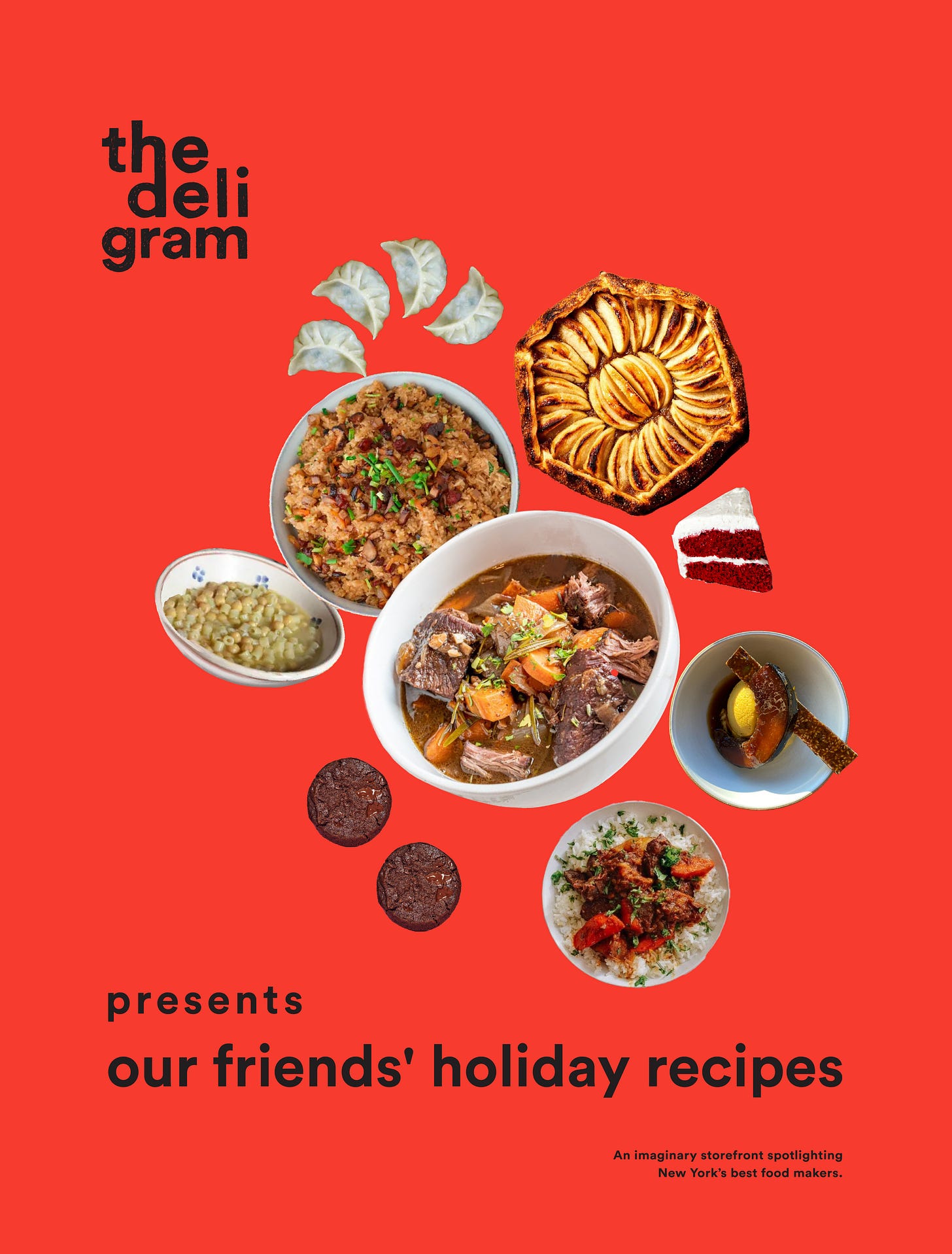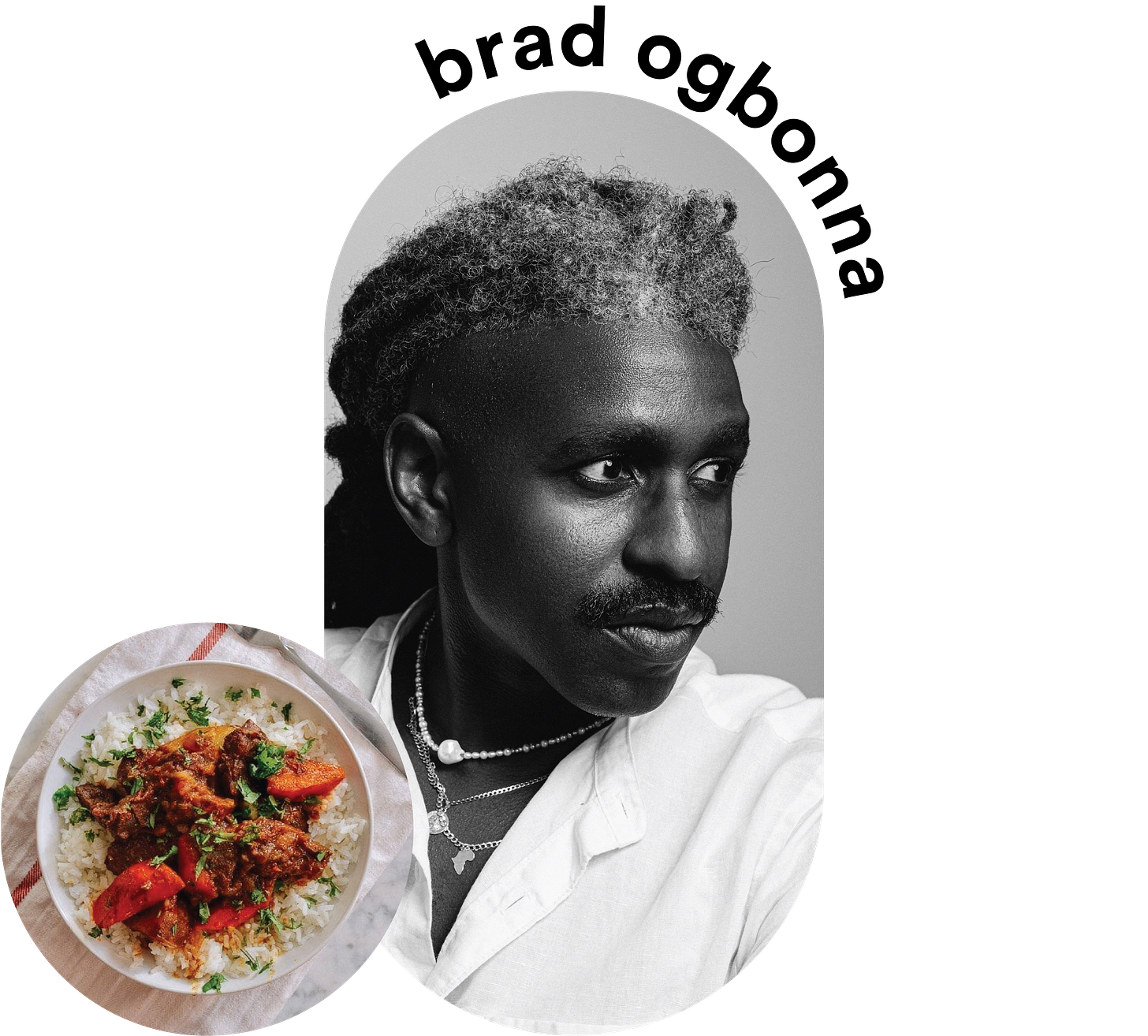Need an instant last minute gift idea? Gift an annual subscription to The Deligram! For $55 you can give someone you love a year of stories, from cookies and cakes to charcuterie and condiments. They will also have access everything that is reserved for premium subscribers, such as extra issues, exclusive access to limited artisanal products, and events. Who knows, if you’re nice they might even share a treat or two. We’re a tiny publication and every subscription helps keep the lights on in a VERY meaningful way. Thank you for all your support this year.
The Deligram shines a spotlight on the many incredible food artisans in New York–and beyond–with a little help from our friends, of course. This week, we asked a few of our friends to share their tried-and-tested recipes that they’re cooking this holiday season, so you can serve up a perfect red velvet cake or boeuf bourguignon with ease.
The Friend: Aminatou Sow, writer and strategist
The Recipe: The boeuf bourguignon in the Larousse Gastronomique. The exact recipe isn’t online, but Anthony Bourdain’s take in the Les Halles book is pretty solid.
“I own my mom’s copy of Larousse Gastronomique from the ‘80s; it’s falling apart. I believe she got it around the time she got married or maybe it was a wedding gift. I wish I could ask but she is no longer with us. She had a real love of and sense of duty about cooking, and I wish she had lived long enough to see home cooks get some shine. Cooking for one’s family is still largely a thankless task and every year of my adult life that passes, I realize how under-appreciated my mother’s cooking was in our household.
I don’t really eat red meat anymore but I don’t feel bad having it once a year in service of nostalgia. A few tips: Ask the butcher for steak cuts and brown them *before* cutting it into cubes. Also from lifelong experience, I find that 2 inch cubes make for the most tender meat. Who cares if I have to cut it with the side of your fork when you’re eating? It’s comfort food, people! Don’t use cooking wine, use a goddamn wine you like. And there is no standard recipe for bouquet garni [a classic herb mixture used in French cooking} so, again, use what you like the most and don’t skimp on anything.”
The Friend: Dorie Greenspan, cookbook author
The Recipe: World Peace Cookies
“I’ve been making World Peace Cookies since I was given the recipe by the French pastry superstar Pierre Hermé more than 20 years ago. Pierre gave me the recipe for my book, Paris Sweets, sometime in the late 1990s. Back then, they were named after the restaurant he’d created them for, Korova. The restaurant opened and closed quickly, but the cookie lived on. Just as I was finishing my manuscript for Baking From My Home to Yours, a neighbor told me that he loved the Korova Cookies, but never called them by their proper name. In his house, they were called World Peace Cookies because he thought that if everyone had them, peace would reign. You can find the whole history of the original cookie here.
The cookie looks (and is) simple – the excitement is in the flavor and texture. It’s a cocoa sable, a French shortbread cookie, made with granulated and brown sugars, like an American chocolate chip. It’s got chunks of dark chocolate and enough fleur de sel to make you pay attention. While we use salt in baking without thinking these days, this cookie was revolutionary at the turn of the last century. Its flavor was more chocolate-y than you’d expect from a cocoa cookie, and its texture was a mix of sandy and chewy.”
The Friend: Brad Ogbonna, photographer
The Recipe: Caribbean Lamb Stew
“Lamb stew feels like the holiday season to me. I'm from and currently live in a place that's cold during the winter so I always look for dishes that feel like a warm hug and this is that for me.
I love that it's generally easy to make - it just takes time to prep. I made it for friends a few weekends ago and it was a really huge hit. The only real modification is that I introduce a couple habanero or scotch bonnet peppers to the dish while I fry the onions. I grew up eating very spicy food so this is a nod to that.”
The Friend: Thessaly La Force, writer and editor
The Recipe: My mother’s jiaozi (Chinese dumplings). The filling is pretty close to this one.
“We grew up eating these dumplings as a family. My mom made them, and her mom made them too. My cousins and I used to have dumpling eating contests. We fold the dumplings together as a family. We even have a press for the less manually skilled among us! It's a very communal way to eat. And simple. Cleanup is also mercifully minimal.
At one point, long after moving to New York, I asked my mom for her recipe because nothing quite beats fresh dumplings. We use prepared dumpling skins that my mom sources in Chinatown and we boil ours instead of pan frying them. I also recommend making your own dumpling sauce, which can be as simple as adding a little chopped garlic and chives to some soy sauce. I'm a big fan of chive and pork filling, if you're looking for variation. (Pro tip: you can buy nice pork, like the shoulder, and ask the butcher to grind it instead of using questionable-looking ground pork.) And, if you have any leftovers, they're just as delicious pan-fried the next day. If for whatever reason you have extra dumplings you didn't boil: freeze them. That's the secret to dumplings. When you're ready to eat them, plop them into boiling water (frozen) and viola.”
The Friend: Myriam Ben Salah, art curator
The Recipe: Rachel Roddy’s Pasta e Ceci
“I have been infatuated with this dish since I tried it a couple of months ago. It is the simplest, most humble of preparations: pasta e ceci (pasta and chickpeas). My friend Anna made it for dinner and it was simmering when I arrived. The smell of it was incredible, it felt like a warm hug.
I like the simplicity of it, it's a humble dish, unpretentious and very satisfying. If you make it right there is an interesting contrast between the al dente quality of the pasta and the tenderness of the chickpeas. The last drizzle of olive oil is crucial. [When I make it,] I use ditalini instead of the broken lasagna sheets used in the recipe. I prefer the firmness of a small pasta.”
The Friend: Brian McGinn, director
The Recipe: Fuyuko Kondo's Apple Galette
“This Apple Galette is just extremely, extremely delicious. There's something incredibly satisfying about working to recreate something that you love to eat — that's one of the joys of cooking from recipes — and Fuyuko's baking is so worthy of that goal. I first heard about Fuyuko's amazing baked goods on Instagram from Bill Addison, and the first time I tried her incredible galettes I was hooked. They're not too sweet — I don't like overly sweet desserts — with a savory, wonderfully buttery pastry that she makes using local Tehachapi Grain Project wheat (the recipe specifies All Purpose flour). I haven't tried using Tehachapi's Sonora wheat yet, but that's next on my list!”
The Friend: Tony Ortiz, chef
The Recipe: Calabaza en Tacha
“I love cooking calabaza enmielada, which is caramelized pumpkin. My grandparents have this as a dessert during pumpkin season, usually in a bowl of buttermilk. One summer I grew endless amounts of kabocha squash and we would make it for dessert each week. I like to use kabocha squash, due to the skin being thin and edible and the bright orange color of the flesh.
I love the simplicity of it, you throw it all in a pot and let the gentle heat do its work. To me, it is the perfect example of slow Mexican country cooking, showcasing the beautiful flavor of kabocha and warm spices. It is a versatile dish, you can add fresh whipped cream to it or some homemade vanilla bean ice cream. I let the squash sit in limestone or “cal” water overnight in order to hold its shape better and prevent the squash from turning into mush. My tip: if you are cooking large pieces of pumpkin, use a hotel pan, layer the wedges on it and pour in water, piloncillo and spices. Cover it, and let it cook at 375 for about 40-50 minutes.”
The Friend: Emilia Petrarca, fashion writer
The Recipe: The Red Velvet Cake and cream cheese icing from The New York Times
“Every year since high school, I've baked this triple-layer red velvet cake and thrown a red velvet-themed holiday party around it. (Because of the pandemic, I haven't hosted since 2019, but this year we're making a comeback.) I think my mom showed it to me way back when, although I don't think she'd ever made it before. I remember baking it for the first time with my high school boyfriend. He was annoyed at how many steps were involved, and doesn't even like red velvet cake. But he helped me anyway! Ah, young love. (I think he was bored.)
This cake is decadent. The three layers make it look fancy and over-the-top, but it's actually not that hard to make. Plus, it tastes like chocolate, which is maybe the most important part to me, and the cream cheese frosting balances it out. Any modifications I’ve made in the past have been huge mistakes–stick to the recipe.”
The Friend: Greg Wong, chef
The Recipe: Lao Mai Fan. “This recipe is pretty good and similar to my mom's.”
“It's a traditional Cantonese dish and my mom would make it often, especially during the holidays. It reminds me of home and it's incredibly craveable! It's a balance of something that's really rustic, but elegant and luxurious in its ingredients.
It can be made similar to risotto where rice is toasted and stock is slowly added to cook. However, we usually used a simpler, but equally delicious way of making it that cooks rice separately, then focuses on toasting all the aromatics, cured meats, dried seafood to perfection. When my family ate it, my mom would serve it with a side of lettuce. We essentially made little lettuce wraps with this super umami rich rice. I also like adding a bit of dried scallop to really boost the dried seafood flavor. The play of sticky rice, crispy bits of cured meat, toasted shrimp, and then crisp cold lettuce is a little dance in your mouth.”
Want more? Check out photographer Andrea Gentl’s recipe for a magical flourless chocolate cake from a recent issue.
Edited by Sarah Leon.














